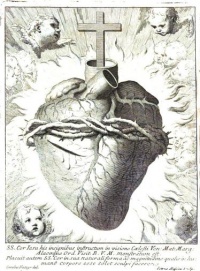Human body
From The Art and Popular Culture Encyclopedia
| Revision as of 20:46, 25 March 2024 Jahsonic (Talk | contribs) ← Previous diff |
Revision as of 06:33, 8 May 2024 Jahsonic (Talk | contribs) Next diff → |
||
| Line 7: | Line 7: | ||
| {{Template}} | {{Template}} | ||
| - | The '''human body''' is the entire structure of a [[human]] [[organism]] and comprises a [[human head|head]], [[neck]], [[torso]], two [[arm]]s and two [[human leg|leg]]s. | + | The '''human body''' is the entire [[structure[[ of a [[Human|human being]]. It is composed of many different types of [[Cell (biology)|cells]] that together create [[Tissue (biology)|tissues]] and subsequently [[organs]] and then [[organ systems]]. They ensure [[homeostasis]] and the [[life|viability]] of the human body. |
| - | By the time the human reaches [[adulthood]], the body consists of close to 100 [[Orders of magnitude (numbers)#1012|trillion]] [[Cell (biology)|cells]], the basic unit of [[life]]. These cells are [[biological organisation|organised biologically]] to eventually form the whole body. | + | |
| + | It consists of [[human head|head]], [[hair]], [[neck]], [[torso]] (which includes the [[thorax]] and [[abdomen]]), [[arm]]s and [[hands]], [[human leg|legs]] and [[feet]]. | ||
| + | |||
| + | The study of the human body includes [[anatomy]], [[physiology]], [[histology]] and [[embryology]]. The body [[anatomical variability|varies anatomically]] in known ways. Physiology focuses on the systems and organs of the human body and their functions. Many systems and mechanisms interact in order to maintain [[homeostasis]], with safe levels of substances such as sugar and [[oxygen]] in the blood. | ||
| + | |||
| + | The body is studied by [[health professional]]s, physiologists, anatomists, and artists to assist them in their work. | ||
| + | |||
| ==Reproductive system== | ==Reproductive system== | ||
Revision as of 06:33, 8 May 2024
|
The first thing that presents itself to man, when he surveys himself, is his body.--Pascal |

|
Related e |
|
Featured: |
The human body is the entire [[structure[[ of a human being. It is composed of many different types of cells that together create tissues and subsequently organs and then organ systems. They ensure homeostasis and the viability of the human body.
It consists of head, hair, neck, torso (which includes the thorax and abdomen), arms and hands, legs and feet.
The study of the human body includes anatomy, physiology, histology and embryology. The body varies anatomically in known ways. Physiology focuses on the systems and organs of the human body and their functions. Many systems and mechanisms interact in order to maintain homeostasis, with safe levels of substances such as sugar and oxygen in the blood.
The body is studied by health professionals, physiologists, anatomists, and artists to assist them in their work.
Reproductive system
Human reproduction takes place as internal fertilization by sexual intercourse. During this process, the erect penis of the male is inserted into the female's vagina until the male ejaculates semen, which contains sperm, into the female's vagina. The sperm then travels through the vagina and cervix into the uterus or fallopian tubes for fertilization of the ovum.
See also
- See Mikhail Bakhtin's concept of the grotesque body and notes on an embodied philosophy.
- Anatomical wax model
- Anatomy
- Bodily function
- Body orifices
- Body parts
- Body politics
- Body genres
- Death
- Disease
- Embodied philosophy
- Grotesque body
- Human beauty
- Human biology
- Health
- John Bell
- Orifice
- Somatopia
- Ugliness
- Vesalius
- Visceral


